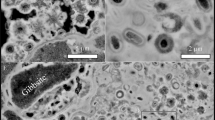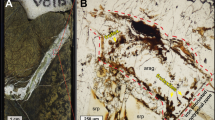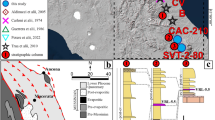Abstract
Microstructures in the ∼3.5 Gyr Apex Chert Formation were initially described as the oldest bacterial fossils on Earth over 20 years ago1. However, the identification of the structures (which resemble cyanobacteria) as biological in origin remains controversial1,2,3,4,5,6,7,8,9,10,11,12,13. Here we determine the petrology and geochemistry of similar structures from the original Apex Chert locality using thin sections and Raman spectroscopy. Based on the microscopic examination of thin sections, we identify features similar to those previously identified as microfossils as a series of quartz and haematite-filled fractures. Raman spectroscopy of the fractures shows that carbonaceous material is not, as previously reported, associated with the structures, but is instead disseminated in the surrounding quartz matrix. We suggest that although the microstuctures analysed are not microfossils, the presence of carbonaceous material in the surrounding matrix is consistent with the existence of microbial life at this time, and with evidence of early Archaean life14,15 found at other sites. Furthermore, we caution against identifying microstructures as biological in origin without a full morphological and geochemical assessment.
This is a preview of subscription content, access via your institution
Access options
Subscribe to this journal
Receive 12 print issues and online access
$259.00 per year
only $21.58 per issue
Buy this article
- Purchase on Springer Link
- Instant access to full article PDF
Prices may be subject to local taxes which are calculated during checkout



Similar content being viewed by others
References
Schopf, J. W. & Packer, B. M. Early Archean (3.3-billion to 3.5-billion-year-old) microfossils from Warrawoona Group, Australia. Science 237, 70–73 (1987).
Brasier, M. D. et al. Questioning the evidence for Earth’s oldest fossils. Nature 416, 76–81 (2002).
Brasier, M. D., Green, O. R., Lindsay, J. F. & Steele, A. Earth’s oldest (3.5 Gyr) fossils and the ‘Early Eden’ hypothesis: Questioning the evidence. Origins Life Evol. B 34, 257–269 (2004).
Brasier, M. D., McLoughlin, N., Green, O. R. & Wacey, D. A A fresh look at the fossil evidence for early Archaean cellular life. Phil. Trans. R. Soc. B 361, 887–902 (2006).
Brasier, M. D. et al. Critical testing of Earth’s oldest putative fossil assemblage from the ∼3.5 Gyr Apex chert, Chinaman Creek, Western Australia. Precambr. Res. 140, 55–102 (2005).
De Gregorio, B. T., Sharp, T. G., Flynn, G. J., Wirick, S. & Hervig, R. L. Biogenic origin for Earth’s oldest putative microfossils. Geology 37, 631–634 (2009).
Pasteris, J. D. & Wopenka, B. Necessary, but not sufficient: Raman identification of disordered carbon as a signature of ancient life. Astrobiology 3, 727–738 (2003).
Pinti, D. L., Mineau, R. & Clement, V. Hydrothermal alteration and microfossil artefacts of the 3,465-million-year-old Apex chert. Nature Geosci. 2, 640–643 (2009).
Schopf, J. W. Microfossils of the early Archean Apex Chert: New evidence of the antiquity of life. Science 260, 640–646 (1993).
Schopf, J. W. in The Precambrian Earth: Tempos and Events (Developments in Precambrian Geology 12) (eds Eriksson, P. G., Altermann, W., Nelson, D. R., Mueller, W. U. & Cateneanu, O.) 516–539 (Elsevier, 2004).
Schopf, J. W. & Kudryavtsev, A. B. Confocal laser scanning microscopy and Raman imagery of ancient microscopic fossils. Precambr. Res. 173, 39–49 (2009).
Schopf, J. W., Kudryavtsev, A. B., Agresti, D. G., Wdowiak, T. J. & Czaja, A. D. Laser-Raman imagery of Earth’s earliest fossils. Nature 416, 73–76 (2002).
Schopf, J. W., Kudryavtsev, A. B., Czaja, A. D. & Tripathi, A. B. Evidence of Archean life: Stromatolites and microfossils. Precambr. Res. 158, 141–155 (2007).
Walsh, M. M. & Lowe, D. R.. Filamentous microfossils from the 3,500-Myr-old Onverwacht Group, Barberton Mountain Land, South Africa. Nature 314, 530–532 (1985).
Walsh, M. M. Microfossils and possible microfossils from the Early Archean Onverwacht Group, Barberton Mountain Land, South Africa. Precambr. Res. 54, 271–293 (1992).
Knoll, A. H. & Walter, M. W. The limits of palaeontological knowledge: Finding the gold among the dross. Ciba Found. Symp. 202, 198–209 (1996).
Van Kranendonk, M. L. & Pirajno, F. Geochemistry of metabasalts and hydrothermal alteration zones associated with c. 3.45 Gyr chert and barite deposits: Implications for the geological setting of the Warrawoona Group, Pilbara Craton, Australia. Geochem. Explorat. Environ. Anal. 4, 253–278 (2004).
de Faria, D. L. A., Silva, S. V. & de Oliveira, M. T. Raman microspectroscopy of some iron oxides and oxyhydroxides. J. Raman Spectrosc. 28, 873–878 (1997).
Wang, L., Zhu, J., Yan, Y., Xie, Y. & Wang, C. Micro-structural characterization of red decorations of red and green colour porcelain. J. Raman Spectrosc. 40, 998–1003 (2004).
Kingma, K. J. & Hemley, R. J. Raman spectroscopic study of microcrystalline silica. Am. Mineral. 79, 269–273 (1994).
Marshall, C. P., Edwards, H. G. M. & Jehlicka, J. Understanding the application of Raman spectroscopy to the detection of traces of life. Astrobiology 10, 229–243 (2010).
Pasteris, J. D. & Wopenka, B. Raman spectra of graphite as indicators of degree of metamorphism. Can. Mineral. 29, 1–9 (1991).
Yan, J. Laser micro-Raman spectroscopy of single-point diamond machined silicon substrates. J. Appl. Phys. 95, 2094–2101 (2004).
Schopf, J. W. & Kudryavtsev, A. B. Three-dimensional Raman imagery of Precambrian microscopic organisms. Geobiology 3, 1–12 (2005).
Toporski, J., Fries, M., Steele, A., Nittler, L. & Kress, M. Sweeping the skies: Stardust and the origin of our Solar System. GIT Imaging Microsc. 4, 38–40 (2004).
Schopf, J. W., Kudryavtsev, A. B., Sugitani, K. & Walter, M. W. Precambrian microbe-like pseudofossils: A promising solution to the problem. Precambr. Res. 179, 191–205 (2010).
Nicholson, R & Ejiofor, I. B. The three-dimensional morphology of arrays of echelon and sigmoidal, mineral-filled fractures: Data from north Cornwall. J. Geol. Soc. 144, 79–83 (1987).
Boyd, T. D. & Scott, S. D. Microbial and hydrothermal aspects of ferric oxyhydroxodes and ferrosic hydroxides: The example of Franklin Seamount, Western Woodlark Basin, Papua New Guinea. Geochem. Trans. 2, 45–56 (2001).
Parenteau, M. N. & Cady, S. L. Microbial biosignatures in iron-mineralized phototrophic mats at Chocolate Pots Hot Springs, Yellowstone National Park, United States. Palaios 25, 97–111 (2010).
Dalton, R. Microfossils: Squaring up over ancient life. Nature 417, 782–784 (2002).
Acknowledgements
Thanks to Australian Research Council for funding, M. Walter and M. Van Kranendonk for field assistance and helpful discussions, R. Goldstein for paragenesis advice, and A. Walton for access to his colour photomicrography facility.
Author information
Authors and Affiliations
Contributions
C.P.M. collected the samples, J.R.E. collected the Raman data, A.O.M. and J.R.E. collected the photomicrographs, C.P.M. and A.O.M. interpreted the data, and A.O.M. wrote the paper with contributions from C.P.M.
Corresponding author
Ethics declarations
Competing interests
The authors declare no competing financial interests.
Supplementary information
Supplementary Information
Supplementary Information (PDF 1087 kb)
Rights and permissions
About this article
Cite this article
Marshall, C., Emry, J. & Olcott Marshall, A. Haematite pseudomicrofossils present in the 3.5-billion-year-old Apex Chert. Nature Geosci 4, 240–243 (2011). https://doi.org/10.1038/ngeo1084
Received:
Accepted:
Published:
Issue Date:
DOI: https://doi.org/10.1038/ngeo1084
This article is cited by
-
The role of volcanic-derived clays in the preservation of Ediacaran biota from the Itajaí Basin (ca. 563 Ma, Brazil)
Scientific Reports (2021)
-
High-fidelity and high-resolution phase mapping of granites via confocal Raman imaging
Scientific Reports (2021)



